Legal Analysis: Employee Rights, Trademark Law, & Negligence Case
VerifiedAdded on 2023/06/18
|8
|2433
|469
Report
AI Summary
This assignment provides an overview of key business law concepts, focusing on employee rights, trademark law, and negligence. It examines the legal protections available to employees facing dismissal, referencing the Employees Right Act 1996 and relevant case law. The report assesses the rules governing trademarks under intellectual property law, highlighting their importance in protecting brand identity and preventing infringement. It also analyzes the significance of the Caparo v Dickman (1990) case in establishing the modern approach to duty of care in negligence, exploring its implications for auditors and other professionals. The document concludes by emphasizing the role of business laws in regulating business operations and ensuring fair practices.
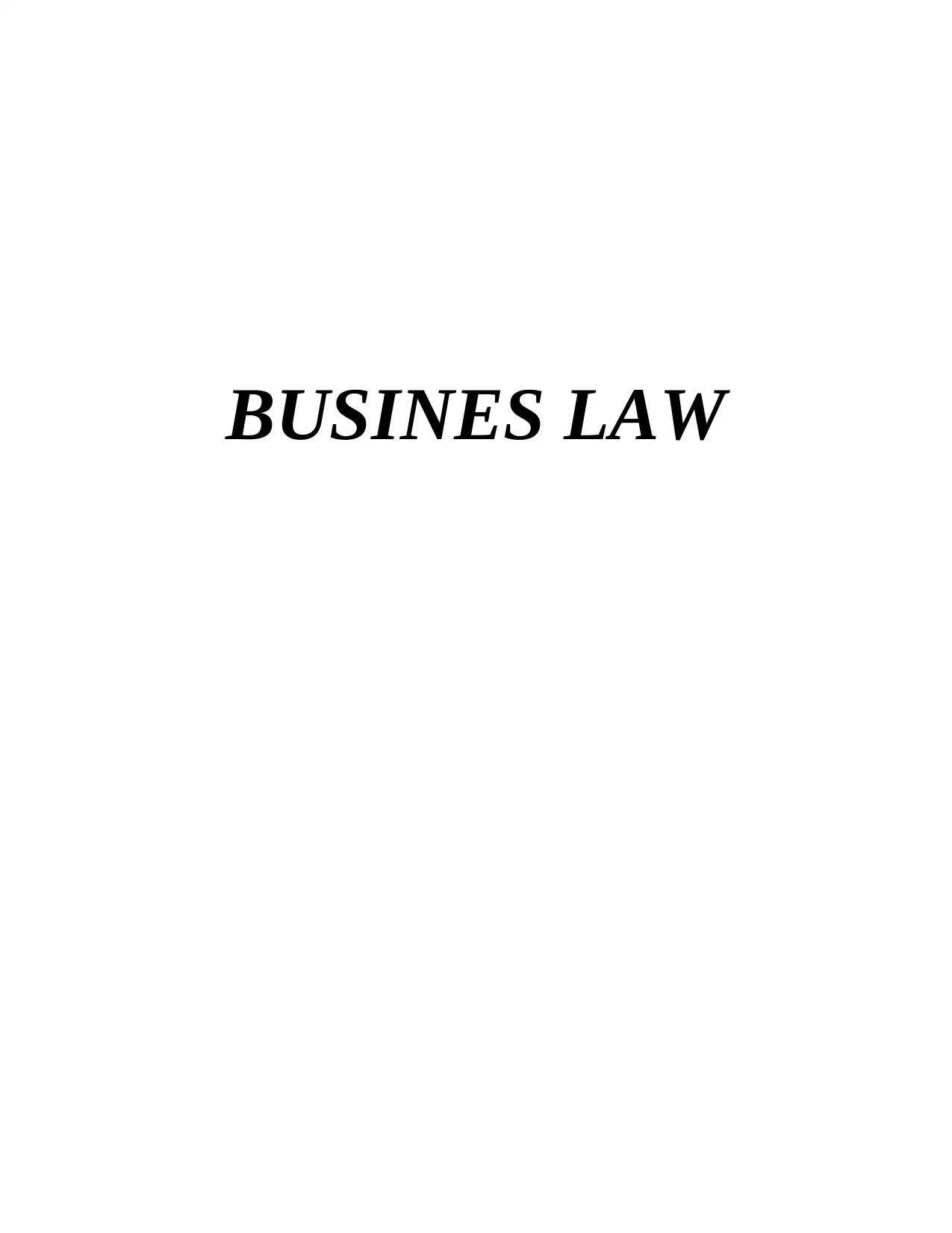
BUSINES LAW
Paraphrase This Document
Need a fresh take? Get an instant paraphrase of this document with our AI Paraphraser
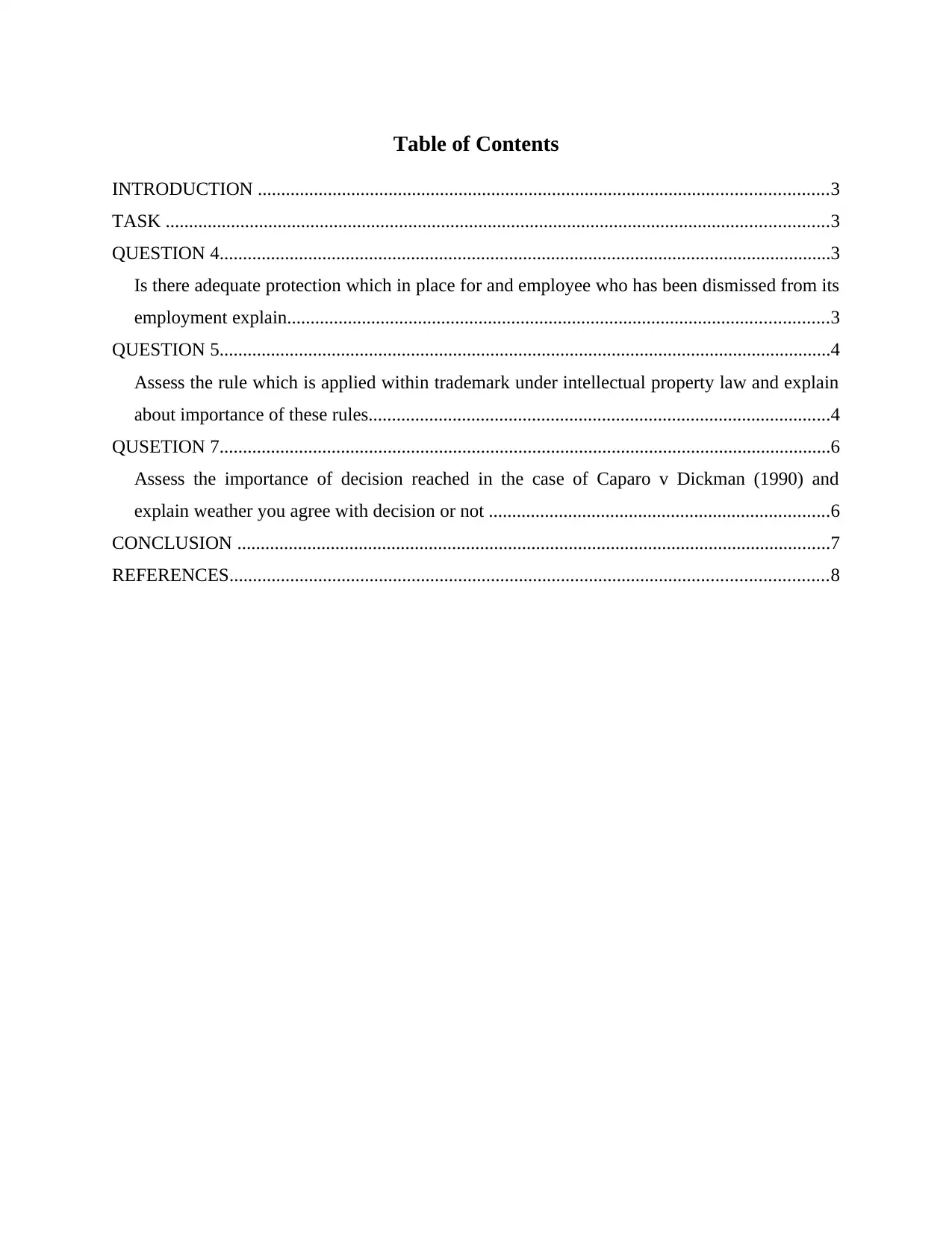
Table of Contents
INTRODUCTION ..........................................................................................................................3
TASK ..............................................................................................................................................3
QUESTION 4...................................................................................................................................3
Is there adequate protection which in place for and employee who has been dismissed from its
employment explain....................................................................................................................3
QUESTION 5...................................................................................................................................4
Assess the rule which is applied within trademark under intellectual property law and explain
about importance of these rules...................................................................................................4
QUSETION 7...................................................................................................................................6
Assess the importance of decision reached in the case of Caparo v Dickman (1990) and
explain weather you agree with decision or not .........................................................................6
CONCLUSION ...............................................................................................................................7
REFERENCES................................................................................................................................8
INTRODUCTION ..........................................................................................................................3
TASK ..............................................................................................................................................3
QUESTION 4...................................................................................................................................3
Is there adequate protection which in place for and employee who has been dismissed from its
employment explain....................................................................................................................3
QUESTION 5...................................................................................................................................4
Assess the rule which is applied within trademark under intellectual property law and explain
about importance of these rules...................................................................................................4
QUSETION 7...................................................................................................................................6
Assess the importance of decision reached in the case of Caparo v Dickman (1990) and
explain weather you agree with decision or not .........................................................................6
CONCLUSION ...............................................................................................................................7
REFERENCES................................................................................................................................8
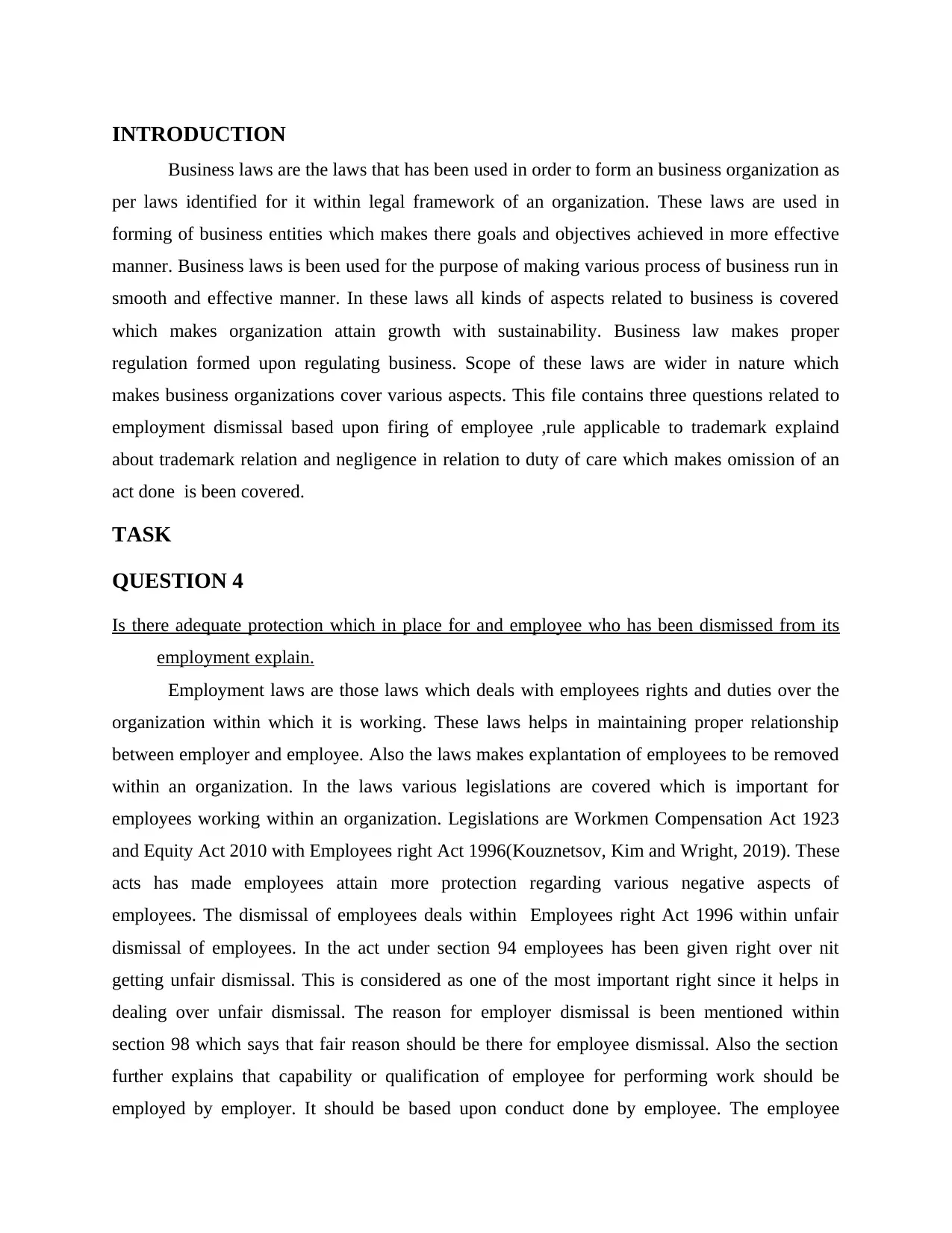
INTRODUCTION
Business laws are the laws that has been used in order to form an business organization as
per laws identified for it within legal framework of an organization. These laws are used in
forming of business entities which makes there goals and objectives achieved in more effective
manner. Business laws is been used for the purpose of making various process of business run in
smooth and effective manner. In these laws all kinds of aspects related to business is covered
which makes organization attain growth with sustainability. Business law makes proper
regulation formed upon regulating business. Scope of these laws are wider in nature which
makes business organizations cover various aspects. This file contains three questions related to
employment dismissal based upon firing of employee ,rule applicable to trademark explaind
about trademark relation and negligence in relation to duty of care which makes omission of an
act done is been covered.
TASK
QUESTION 4
Is there adequate protection which in place for and employee who has been dismissed from its
employment explain.
Employment laws are those laws which deals with employees rights and duties over the
organization within which it is working. These laws helps in maintaining proper relationship
between employer and employee. Also the laws makes explantation of employees to be removed
within an organization. In the laws various legislations are covered which is important for
employees working within an organization. Legislations are Workmen Compensation Act 1923
and Equity Act 2010 with Employees right Act 1996(Kouznetsov, Kim and Wright, 2019). These
acts has made employees attain more protection regarding various negative aspects of
employees. The dismissal of employees deals within Employees right Act 1996 within unfair
dismissal of employees. In the act under section 94 employees has been given right over nit
getting unfair dismissal. This is considered as one of the most important right since it helps in
dealing over unfair dismissal. The reason for employer dismissal is been mentioned within
section 98 which says that fair reason should be there for employee dismissal. Also the section
further explains that capability or qualification of employee for performing work should be
employed by employer. It should be based upon conduct done by employee. The employee
Business laws are the laws that has been used in order to form an business organization as
per laws identified for it within legal framework of an organization. These laws are used in
forming of business entities which makes there goals and objectives achieved in more effective
manner. Business laws is been used for the purpose of making various process of business run in
smooth and effective manner. In these laws all kinds of aspects related to business is covered
which makes organization attain growth with sustainability. Business law makes proper
regulation formed upon regulating business. Scope of these laws are wider in nature which
makes business organizations cover various aspects. This file contains three questions related to
employment dismissal based upon firing of employee ,rule applicable to trademark explaind
about trademark relation and negligence in relation to duty of care which makes omission of an
act done is been covered.
TASK
QUESTION 4
Is there adequate protection which in place for and employee who has been dismissed from its
employment explain.
Employment laws are those laws which deals with employees rights and duties over the
organization within which it is working. These laws helps in maintaining proper relationship
between employer and employee. Also the laws makes explantation of employees to be removed
within an organization. In the laws various legislations are covered which is important for
employees working within an organization. Legislations are Workmen Compensation Act 1923
and Equity Act 2010 with Employees right Act 1996(Kouznetsov, Kim and Wright, 2019). These
acts has made employees attain more protection regarding various negative aspects of
employees. The dismissal of employees deals within Employees right Act 1996 within unfair
dismissal of employees. In the act under section 94 employees has been given right over nit
getting unfair dismissal. This is considered as one of the most important right since it helps in
dealing over unfair dismissal. The reason for employer dismissal is been mentioned within
section 98 which says that fair reason should be there for employee dismissal. Also the section
further explains that capability or qualification of employee for performing work should be
employed by employer. It should be based upon conduct done by employee. The employee
⊘ This is a preview!⊘
Do you want full access?
Subscribe today to unlock all pages.

Trusted by 1+ million students worldwide
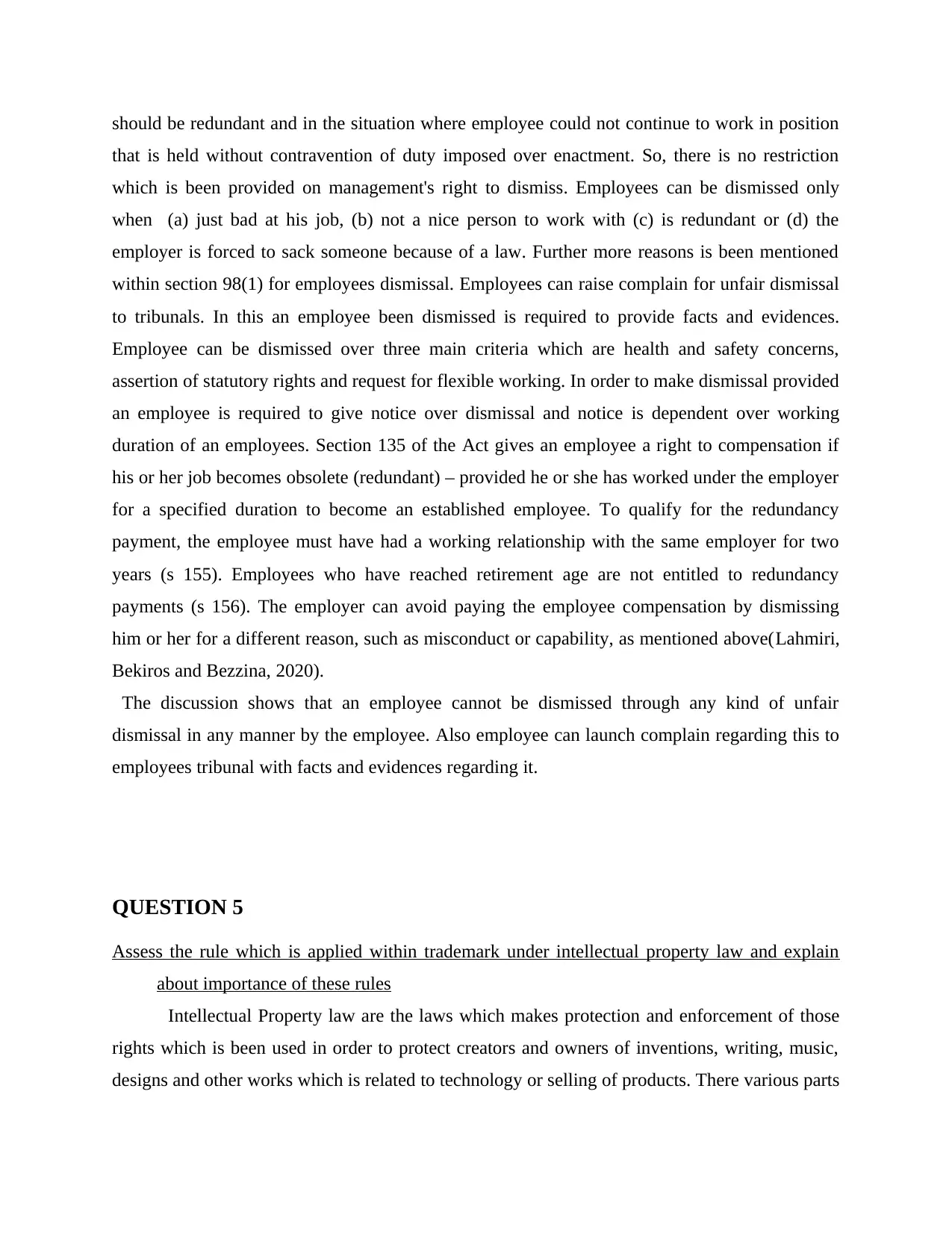
should be redundant and in the situation where employee could not continue to work in position
that is held without contravention of duty imposed over enactment. So, there is no restriction
which is been provided on management's right to dismiss. Employees can be dismissed only
when (a) just bad at his job, (b) not a nice person to work with (c) is redundant or (d) the
employer is forced to sack someone because of a law. Further more reasons is been mentioned
within section 98(1) for employees dismissal. Employees can raise complain for unfair dismissal
to tribunals. In this an employee been dismissed is required to provide facts and evidences.
Employee can be dismissed over three main criteria which are health and safety concerns,
assertion of statutory rights and request for flexible working. In order to make dismissal provided
an employee is required to give notice over dismissal and notice is dependent over working
duration of an employees. Section 135 of the Act gives an employee a right to compensation if
his or her job becomes obsolete (redundant) – provided he or she has worked under the employer
for a specified duration to become an established employee. To qualify for the redundancy
payment, the employee must have had a working relationship with the same employer for two
years (s 155). Employees who have reached retirement age are not entitled to redundancy
payments (s 156). The employer can avoid paying the employee compensation by dismissing
him or her for a different reason, such as misconduct or capability, as mentioned above(Lahmiri,
Bekiros and Bezzina, 2020).
The discussion shows that an employee cannot be dismissed through any kind of unfair
dismissal in any manner by the employee. Also employee can launch complain regarding this to
employees tribunal with facts and evidences regarding it.
QUESTION 5
Assess the rule which is applied within trademark under intellectual property law and explain
about importance of these rules
Intellectual Property law are the laws which makes protection and enforcement of those
rights which is been used in order to protect creators and owners of inventions, writing, music,
designs and other works which is related to technology or selling of products. There various parts
that is held without contravention of duty imposed over enactment. So, there is no restriction
which is been provided on management's right to dismiss. Employees can be dismissed only
when (a) just bad at his job, (b) not a nice person to work with (c) is redundant or (d) the
employer is forced to sack someone because of a law. Further more reasons is been mentioned
within section 98(1) for employees dismissal. Employees can raise complain for unfair dismissal
to tribunals. In this an employee been dismissed is required to provide facts and evidences.
Employee can be dismissed over three main criteria which are health and safety concerns,
assertion of statutory rights and request for flexible working. In order to make dismissal provided
an employee is required to give notice over dismissal and notice is dependent over working
duration of an employees. Section 135 of the Act gives an employee a right to compensation if
his or her job becomes obsolete (redundant) – provided he or she has worked under the employer
for a specified duration to become an established employee. To qualify for the redundancy
payment, the employee must have had a working relationship with the same employer for two
years (s 155). Employees who have reached retirement age are not entitled to redundancy
payments (s 156). The employer can avoid paying the employee compensation by dismissing
him or her for a different reason, such as misconduct or capability, as mentioned above(Lahmiri,
Bekiros and Bezzina, 2020).
The discussion shows that an employee cannot be dismissed through any kind of unfair
dismissal in any manner by the employee. Also employee can launch complain regarding this to
employees tribunal with facts and evidences regarding it.
QUESTION 5
Assess the rule which is applied within trademark under intellectual property law and explain
about importance of these rules
Intellectual Property law are the laws which makes protection and enforcement of those
rights which is been used in order to protect creators and owners of inventions, writing, music,
designs and other works which is related to technology or selling of products. There various parts
Paraphrase This Document
Need a fresh take? Get an instant paraphrase of this document with our AI Paraphraser
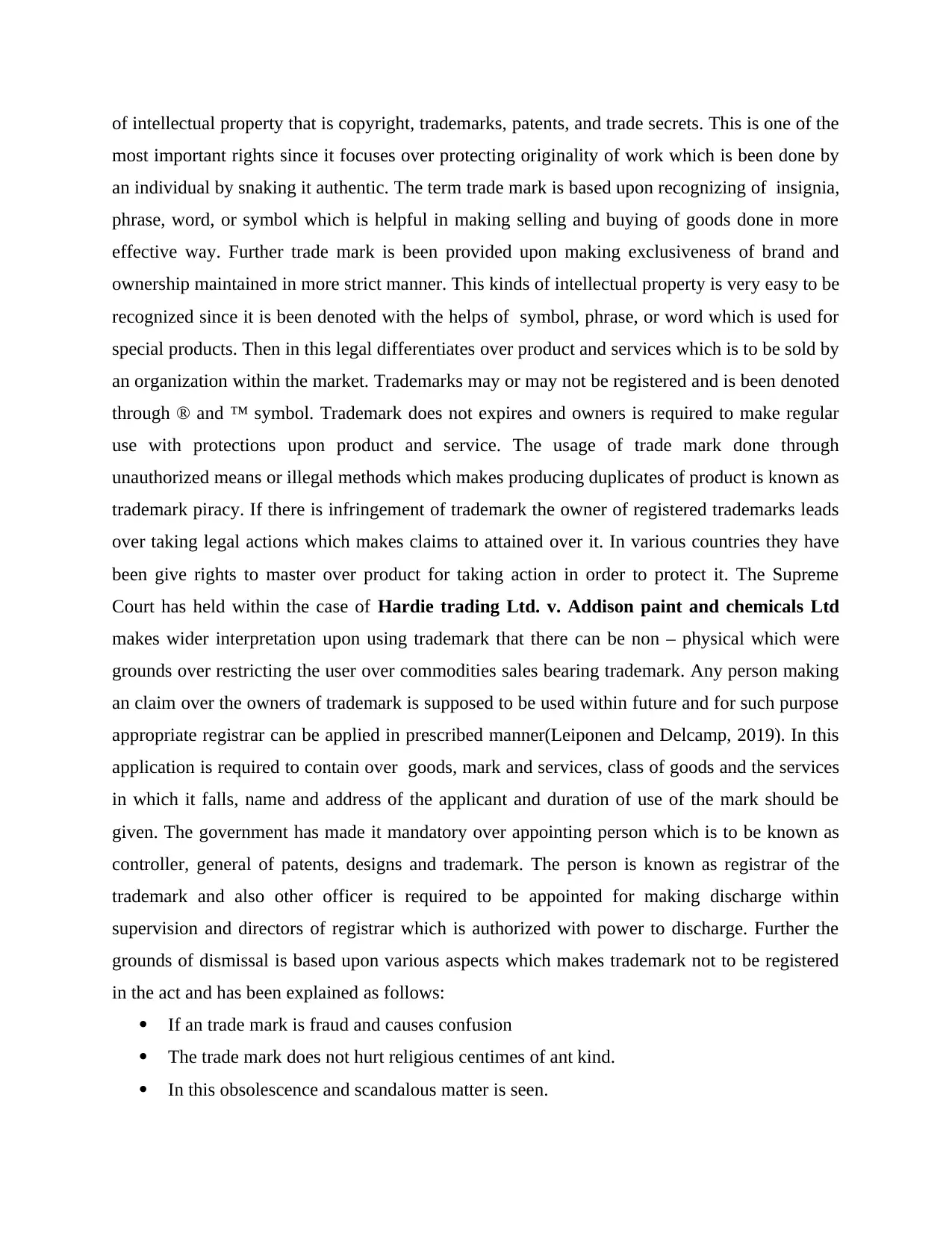
of intellectual property that is copyright, trademarks, patents, and trade secrets. This is one of the
most important rights since it focuses over protecting originality of work which is been done by
an individual by snaking it authentic. The term trade mark is based upon recognizing of insignia,
phrase, word, or symbol which is helpful in making selling and buying of goods done in more
effective way. Further trade mark is been provided upon making exclusiveness of brand and
ownership maintained in more strict manner. This kinds of intellectual property is very easy to be
recognized since it is been denoted with the helps of symbol, phrase, or word which is used for
special products. Then in this legal differentiates over product and services which is to be sold by
an organization within the market. Trademarks may or may not be registered and is been denoted
through ® and ™ symbol. Trademark does not expires and owners is required to make regular
use with protections upon product and service. The usage of trade mark done through
unauthorized means or illegal methods which makes producing duplicates of product is known as
trademark piracy. If there is infringement of trademark the owner of registered trademarks leads
over taking legal actions which makes claims to attained over it. In various countries they have
been give rights to master over product for taking action in order to protect it. The Supreme
Court has held within the case of Hardie trading Ltd. v. Addison paint and chemicals Ltd
makes wider interpretation upon using trademark that there can be non – physical which were
grounds over restricting the user over commodities sales bearing trademark. Any person making
an claim over the owners of trademark is supposed to be used within future and for such purpose
appropriate registrar can be applied in prescribed manner(Leiponen and Delcamp, 2019). In this
application is required to contain over goods, mark and services, class of goods and the services
in which it falls, name and address of the applicant and duration of use of the mark should be
given. The government has made it mandatory over appointing person which is to be known as
controller, general of patents, designs and trademark. The person is known as registrar of the
trademark and also other officer is required to be appointed for making discharge within
supervision and directors of registrar which is authorized with power to discharge. Further the
grounds of dismissal is based upon various aspects which makes trademark not to be registered
in the act and has been explained as follows:
If an trade mark is fraud and causes confusion
The trade mark does not hurt religious centimes of ant kind.
In this obsolescence and scandalous matter is seen.
most important rights since it focuses over protecting originality of work which is been done by
an individual by snaking it authentic. The term trade mark is based upon recognizing of insignia,
phrase, word, or symbol which is helpful in making selling and buying of goods done in more
effective way. Further trade mark is been provided upon making exclusiveness of brand and
ownership maintained in more strict manner. This kinds of intellectual property is very easy to be
recognized since it is been denoted with the helps of symbol, phrase, or word which is used for
special products. Then in this legal differentiates over product and services which is to be sold by
an organization within the market. Trademarks may or may not be registered and is been denoted
through ® and ™ symbol. Trademark does not expires and owners is required to make regular
use with protections upon product and service. The usage of trade mark done through
unauthorized means or illegal methods which makes producing duplicates of product is known as
trademark piracy. If there is infringement of trademark the owner of registered trademarks leads
over taking legal actions which makes claims to attained over it. In various countries they have
been give rights to master over product for taking action in order to protect it. The Supreme
Court has held within the case of Hardie trading Ltd. v. Addison paint and chemicals Ltd
makes wider interpretation upon using trademark that there can be non – physical which were
grounds over restricting the user over commodities sales bearing trademark. Any person making
an claim over the owners of trademark is supposed to be used within future and for such purpose
appropriate registrar can be applied in prescribed manner(Leiponen and Delcamp, 2019). In this
application is required to contain over goods, mark and services, class of goods and the services
in which it falls, name and address of the applicant and duration of use of the mark should be
given. The government has made it mandatory over appointing person which is to be known as
controller, general of patents, designs and trademark. The person is known as registrar of the
trademark and also other officer is required to be appointed for making discharge within
supervision and directors of registrar which is authorized with power to discharge. Further the
grounds of dismissal is based upon various aspects which makes trademark not to be registered
in the act and has been explained as follows:
If an trade mark is fraud and causes confusion
The trade mark does not hurt religious centimes of ant kind.
In this obsolescence and scandalous matter is seen.
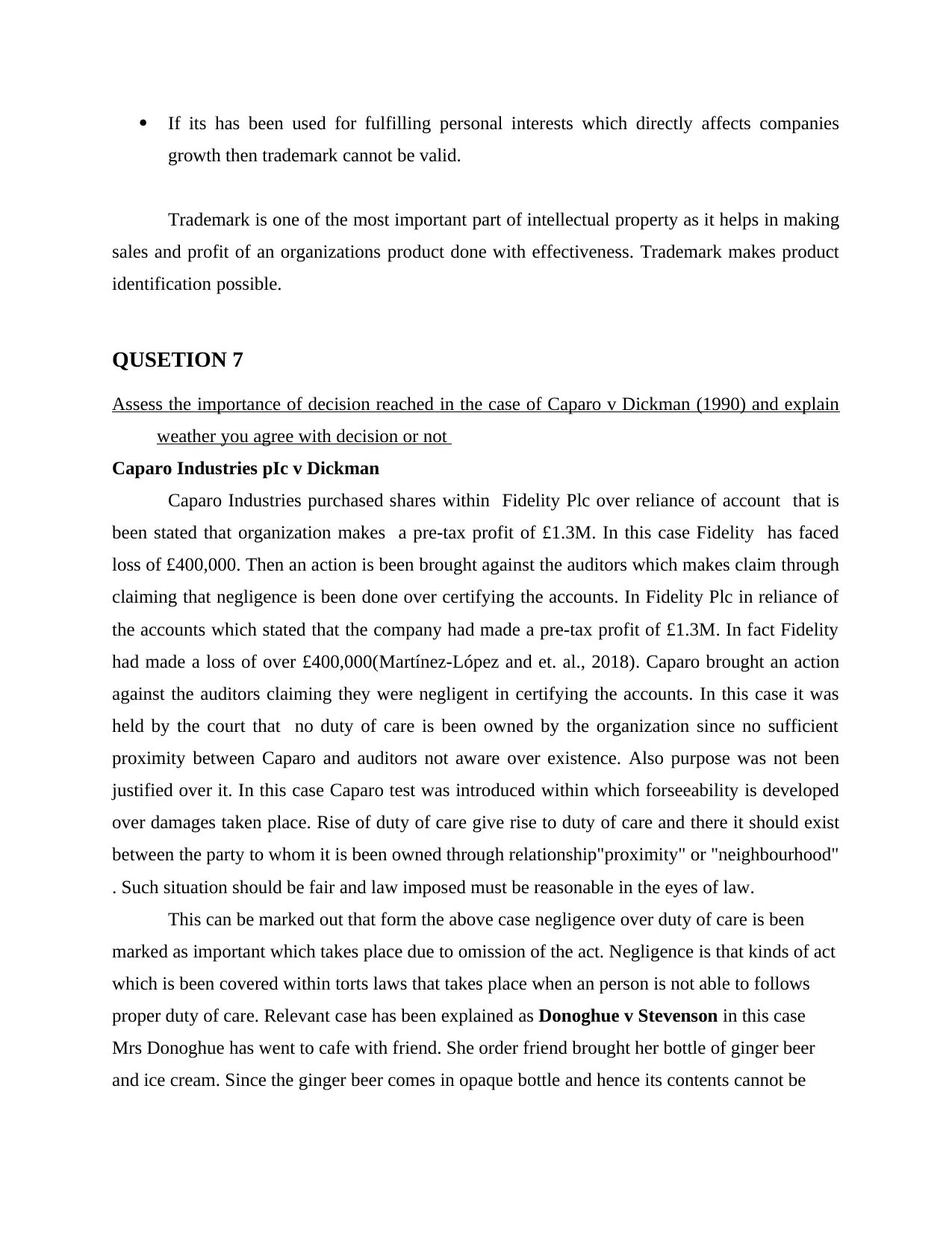
If its has been used for fulfilling personal interests which directly affects companies
growth then trademark cannot be valid.
Trademark is one of the most important part of intellectual property as it helps in making
sales and profit of an organizations product done with effectiveness. Trademark makes product
identification possible.
QUSETION 7
Assess the importance of decision reached in the case of Caparo v Dickman (1990) and explain
weather you agree with decision or not
Caparo Industries pIc v Dickman
Caparo Industries purchased shares within Fidelity Plc over reliance of account that is
been stated that organization makes a pre-tax profit of £1.3M. In this case Fidelity has faced
loss of £400,000. Then an action is been brought against the auditors which makes claim through
claiming that negligence is been done over certifying the accounts. In Fidelity Plc in reliance of
the accounts which stated that the company had made a pre-tax profit of £1.3M. In fact Fidelity
had made a loss of over £400,000(Martínez-López and et. al., 2018). Caparo brought an action
against the auditors claiming they were negligent in certifying the accounts. In this case it was
held by the court that no duty of care is been owned by the organization since no sufficient
proximity between Caparo and auditors not aware over existence. Also purpose was not been
justified over it. In this case Caparo test was introduced within which forseeability is developed
over damages taken place. Rise of duty of care give rise to duty of care and there it should exist
between the party to whom it is been owned through relationship"proximity" or "neighbourhood"
. Such situation should be fair and law imposed must be reasonable in the eyes of law.
This can be marked out that form the above case negligence over duty of care is been
marked as important which takes place due to omission of the act. Negligence is that kinds of act
which is been covered within torts laws that takes place when an person is not able to follows
proper duty of care. Relevant case has been explained as Donoghue v Stevenson in this case
Mrs Donoghue has went to cafe with friend. She order friend brought her bottle of ginger beer
and ice cream. Since the ginger beer comes in opaque bottle and hence its contents cannot be
growth then trademark cannot be valid.
Trademark is one of the most important part of intellectual property as it helps in making
sales and profit of an organizations product done with effectiveness. Trademark makes product
identification possible.
QUSETION 7
Assess the importance of decision reached in the case of Caparo v Dickman (1990) and explain
weather you agree with decision or not
Caparo Industries pIc v Dickman
Caparo Industries purchased shares within Fidelity Plc over reliance of account that is
been stated that organization makes a pre-tax profit of £1.3M. In this case Fidelity has faced
loss of £400,000. Then an action is been brought against the auditors which makes claim through
claiming that negligence is been done over certifying the accounts. In Fidelity Plc in reliance of
the accounts which stated that the company had made a pre-tax profit of £1.3M. In fact Fidelity
had made a loss of over £400,000(Martínez-López and et. al., 2018). Caparo brought an action
against the auditors claiming they were negligent in certifying the accounts. In this case it was
held by the court that no duty of care is been owned by the organization since no sufficient
proximity between Caparo and auditors not aware over existence. Also purpose was not been
justified over it. In this case Caparo test was introduced within which forseeability is developed
over damages taken place. Rise of duty of care give rise to duty of care and there it should exist
between the party to whom it is been owned through relationship"proximity" or "neighbourhood"
. Such situation should be fair and law imposed must be reasonable in the eyes of law.
This can be marked out that form the above case negligence over duty of care is been
marked as important which takes place due to omission of the act. Negligence is that kinds of act
which is been covered within torts laws that takes place when an person is not able to follows
proper duty of care. Relevant case has been explained as Donoghue v Stevenson in this case
Mrs Donoghue has went to cafe with friend. She order friend brought her bottle of ginger beer
and ice cream. Since the ginger beer comes in opaque bottle and hence its contents cannot be
⊘ This is a preview!⊘
Do you want full access?
Subscribe today to unlock all pages.

Trusted by 1+ million students worldwide
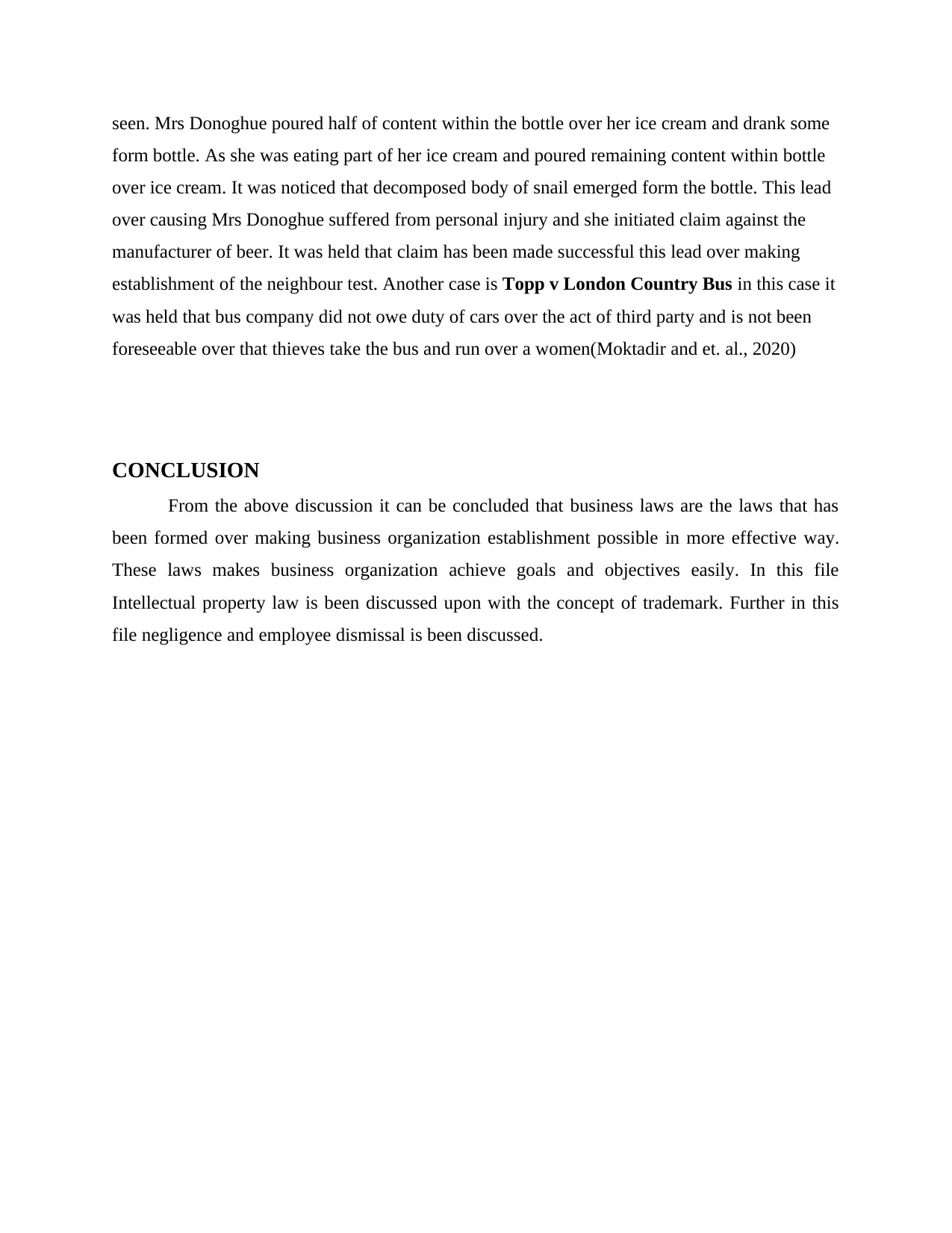
seen. Mrs Donoghue poured half of content within the bottle over her ice cream and drank some
form bottle. As she was eating part of her ice cream and poured remaining content within bottle
over ice cream. It was noticed that decomposed body of snail emerged form the bottle. This lead
over causing Mrs Donoghue suffered from personal injury and she initiated claim against the
manufacturer of beer. It was held that claim has been made successful this lead over making
establishment of the neighbour test. Another case is Topp v London Country Bus in this case it
was held that bus company did not owe duty of cars over the act of third party and is not been
foreseeable over that thieves take the bus and run over a women(Moktadir and et. al., 2020)
CONCLUSION
From the above discussion it can be concluded that business laws are the laws that has
been formed over making business organization establishment possible in more effective way.
These laws makes business organization achieve goals and objectives easily. In this file
Intellectual property law is been discussed upon with the concept of trademark. Further in this
file negligence and employee dismissal is been discussed.
form bottle. As she was eating part of her ice cream and poured remaining content within bottle
over ice cream. It was noticed that decomposed body of snail emerged form the bottle. This lead
over causing Mrs Donoghue suffered from personal injury and she initiated claim against the
manufacturer of beer. It was held that claim has been made successful this lead over making
establishment of the neighbour test. Another case is Topp v London Country Bus in this case it
was held that bus company did not owe duty of cars over the act of third party and is not been
foreseeable over that thieves take the bus and run over a women(Moktadir and et. al., 2020)
CONCLUSION
From the above discussion it can be concluded that business laws are the laws that has
been formed over making business organization establishment possible in more effective way.
These laws makes business organization achieve goals and objectives easily. In this file
Intellectual property law is been discussed upon with the concept of trademark. Further in this
file negligence and employee dismissal is been discussed.
Paraphrase This Document
Need a fresh take? Get an instant paraphrase of this document with our AI Paraphraser
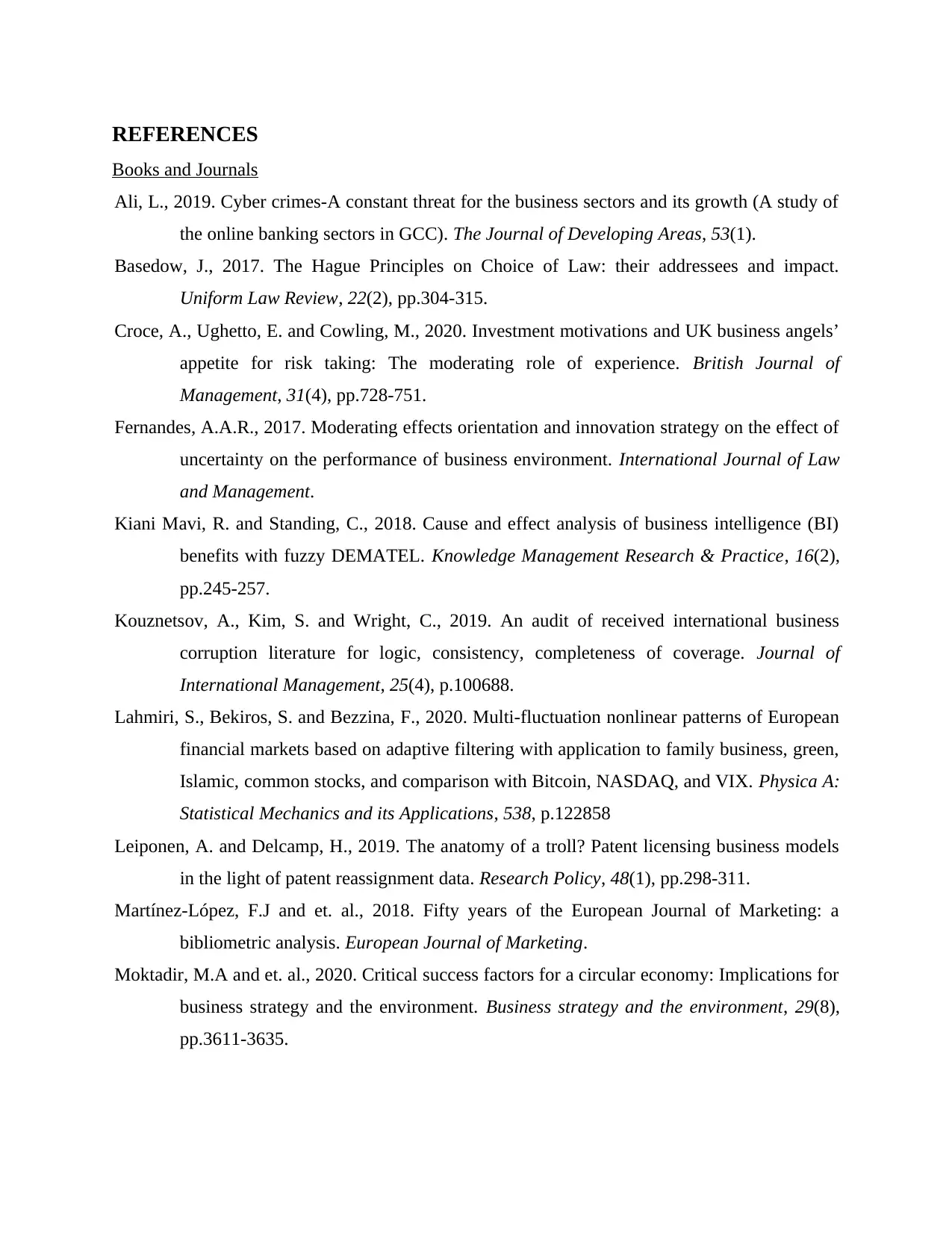
REFERENCES
Books and Journals
Ali, L., 2019. Cyber crimes-A constant threat for the business sectors and its growth (A study of
the online banking sectors in GCC). The Journal of Developing Areas, 53(1).
Basedow, J., 2017. The Hague Principles on Choice of Law: their addressees and impact.
Uniform Law Review, 22(2), pp.304-315.
Croce, A., Ughetto, E. and Cowling, M., 2020. Investment motivations and UK business angels’
appetite for risk taking: The moderating role of experience. British Journal of
Management, 31(4), pp.728-751.
Fernandes, A.A.R., 2017. Moderating effects orientation and innovation strategy on the effect of
uncertainty on the performance of business environment. International Journal of Law
and Management.
Kiani Mavi, R. and Standing, C., 2018. Cause and effect analysis of business intelligence (BI)
benefits with fuzzy DEMATEL. Knowledge Management Research & Practice, 16(2),
pp.245-257.
Kouznetsov, A., Kim, S. and Wright, C., 2019. An audit of received international business
corruption literature for logic, consistency, completeness of coverage. Journal of
International Management, 25(4), p.100688.
Lahmiri, S., Bekiros, S. and Bezzina, F., 2020. Multi-fluctuation nonlinear patterns of European
financial markets based on adaptive filtering with application to family business, green,
Islamic, common stocks, and comparison with Bitcoin, NASDAQ, and VIX. Physica A:
Statistical Mechanics and its Applications, 538, p.122858
Leiponen, A. and Delcamp, H., 2019. The anatomy of a troll? Patent licensing business models
in the light of patent reassignment data. Research Policy, 48(1), pp.298-311.
Martínez-López, F.J and et. al., 2018. Fifty years of the European Journal of Marketing: a
bibliometric analysis. European Journal of Marketing.
Moktadir, M.A and et. al., 2020. Critical success factors for a circular economy: Implications for
business strategy and the environment. Business strategy and the environment, 29(8),
pp.3611-3635.
Books and Journals
Ali, L., 2019. Cyber crimes-A constant threat for the business sectors and its growth (A study of
the online banking sectors in GCC). The Journal of Developing Areas, 53(1).
Basedow, J., 2017. The Hague Principles on Choice of Law: their addressees and impact.
Uniform Law Review, 22(2), pp.304-315.
Croce, A., Ughetto, E. and Cowling, M., 2020. Investment motivations and UK business angels’
appetite for risk taking: The moderating role of experience. British Journal of
Management, 31(4), pp.728-751.
Fernandes, A.A.R., 2017. Moderating effects orientation and innovation strategy on the effect of
uncertainty on the performance of business environment. International Journal of Law
and Management.
Kiani Mavi, R. and Standing, C., 2018. Cause and effect analysis of business intelligence (BI)
benefits with fuzzy DEMATEL. Knowledge Management Research & Practice, 16(2),
pp.245-257.
Kouznetsov, A., Kim, S. and Wright, C., 2019. An audit of received international business
corruption literature for logic, consistency, completeness of coverage. Journal of
International Management, 25(4), p.100688.
Lahmiri, S., Bekiros, S. and Bezzina, F., 2020. Multi-fluctuation nonlinear patterns of European
financial markets based on adaptive filtering with application to family business, green,
Islamic, common stocks, and comparison with Bitcoin, NASDAQ, and VIX. Physica A:
Statistical Mechanics and its Applications, 538, p.122858
Leiponen, A. and Delcamp, H., 2019. The anatomy of a troll? Patent licensing business models
in the light of patent reassignment data. Research Policy, 48(1), pp.298-311.
Martínez-López, F.J and et. al., 2018. Fifty years of the European Journal of Marketing: a
bibliometric analysis. European Journal of Marketing.
Moktadir, M.A and et. al., 2020. Critical success factors for a circular economy: Implications for
business strategy and the environment. Business strategy and the environment, 29(8),
pp.3611-3635.
1 out of 8
Related Documents
Your All-in-One AI-Powered Toolkit for Academic Success.
+13062052269
info@desklib.com
Available 24*7 on WhatsApp / Email
![[object Object]](/_next/static/media/star-bottom.7253800d.svg)
Unlock your academic potential
Copyright © 2020–2025 A2Z Services. All Rights Reserved. Developed and managed by ZUCOL.



